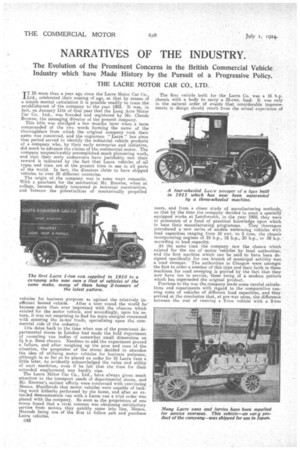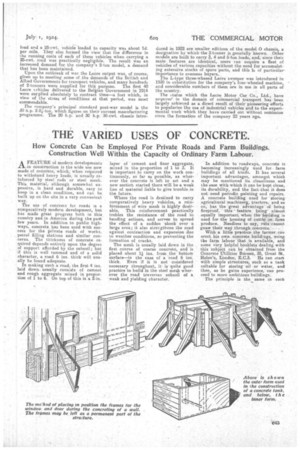NARRATIVES OF THE INDUSTRY.
Page 30

Page 31

If you've noticed an error in this article please click here to report it so we can fix it.
The Evolution of the Prominent Concerns in the British Commercial Vehicle Industry which 'have Made History by the Pursuit of a Progressive Policy.
THE LACRE MOTOR CAR CO., LTD.
IT IS more than a year ago since the Lacre Motor Car Co., Ltd., celebrated their coming of age, so that by means of a simple mental calculation it is possible readily to trace the esta.blishrrent of the company to the year 1902. It was, in fact, on January 11th of that year that the Long Acre Atotor Car Co.. Ltd., was founded and registered by Mr. Claude Browne, the managing director of the present company.
This title was abridged a few months later when, a term compounded of the two words forming the name of the thoroughfare from which the original company took their name was conceived, and the cognomen " Leers " has since that period served to identify the industrial vehicle products of a company who, by their early enterprise and initiative, did much to. advance the claims of the commercial motor. The company unquestionably accomplished much pioneering work, and that their early endeavours have justifiably met their reward is indicated by the fact that Lacre vehicles of all types and sizes are at the present time in use in all parts of the world. In fact, the directors claim to have shipped vehicles to over 30 different countries.
The origin of the company was in some ways romantic. With a penchant for the mechanical Mr. Browne, when at college, became deeply interested in motorcar construction, and foresaw the potentialities of mechanically propelled vehicles for business purposes as against the relatively inefficient horsed vehicle.. After a tour. round the world he became more than ever impressed with the chances which existed for the motor vehicle, and accordingly, upon his return, it was not surprising to find his main energies concerned with entering the motor trade, specializing upon the commercial side of the industry. 1 his dates back to the time when one of the prominent departmental stores in London had made the bold experiment of mounting van bodies of somewhat small dimensions On h.p. Benz chassis. Needless to add the experiment proved a failure, and after weighing up the pros and cons of the situation, the proprietor of the stores decided to abandon the idea of utilizing motor vehicles for business purposes, although in so far as he placed an order for 16 Lacre vans a little later, he evidently acknowledged the value and utility of such machines, even if he felt that the time for their extended employment was hardly ripe. The Lacre Motor Car Co., Ltd., have always given much attention to the transport needs of departmental stores, and Mr. Browne's earliest efforts were concerned with convincing Messrs. Shoolbreds that motor vehicles were capable of tackling work hitherto performed by the horse, and after an extended demonstration. run with a Lacre van a trial order was placed with the company. So soon as the proprietors of one stores found that a rival concern was obtaining satisfactory service from motors they quickly came into line, Messrs. Harrods being one of the first to follow suit and purchase Lacre vehicles.
C42 The first vehicle built for the Lacre Co. was a 16 h.p. chassis with a body to carry a 25-cwt. load. It was only in the natural order of events that considerable improvements in design should result from the actual experience of users, and from a closer study of manufacturing method5 so that by the time the company decided to erect a specially equipped works at Letchworth, in the year 1909, they were in possession of a fund of practical knowledge upon which to base their manufacturing programme. They thereupon introduced a new series of models embracing vehicles with load capacities ranging from 10 cwt. to 5 tons, the chassis incorporating engines of 15 h.p., 18 h.p., 30 h.p., or 38 h.p. •. according to load capacity.
At the same time the company saw the chance which existed for the use of motor vehicles by local authorities, and the first machine which can be said to have been designed specifically for one branch of municipal activity was a road sweeper. The authorities in Glasgow were amongst the first to order a number of this type and their faith in these machines for road sweeping is-proved by the fact that they now have ten in service, these being of a modern pattern which has superseded the original product..
Previous to the war the company made some careful calculations and experiments with regard to the comparative running costs of vehicles of different load capacities, and they arrived at the conclusion that, at pre-war rates, the difference between the cost of running a 2-ton vehicle with a 2-ton load and a 25-cwt. vehicle loaded to capacity was about 1d. per mile. They also formed the view that the difference in the running costs of each of these vehicles when carrying a 25-cwt. toad was practically negligible. The result was an increased demand for the company's 2-ton model, a demand that has been maintained. •
Upon the outbreak of war the Lacre output was, of course, given up to meeting some of the demands of the British and Allied Governments for transport vehicles, and many hundreds of 2-tonners were supplied for thiS purpose. The first 40 Lacre ve,bieles delivered to the Belgian Government in 1914 were surplied absolutely to contract time—a feat which, in view of the stress of conditions at that period, was most commendable.
The eompany's principal standard post-war model is the 30 h.p. 2-21-ton, which figures on their current manufacturing programme. The 20 h.p. and 30 h.p, 30-ewt. chassis intro. duced in 1922 are smaller editions of the model 0 chassis, a designation by which the 2-tonner is generally known. Other models are built to carry 3, 4 and 5-ton loads, and, since their main features are identical, users can acquire a fleet of vehicles of various capacities without the need for accumulating extensive stocks of spare parts, and this Is of particular' importance to overseas buyers.
The L-type three-wheeed Lacre sweeper was introduced in 1920 in substitution for the company's four-wheeled machine, and considerable numbers of them are in use in all parts of the country.
The status which the Leers Motor Car Co., Ltd., have acquirer in the domain of coirimercial transport has been . largely achieved as a direct result of their pioneering efforts to popularize the use of industrial vehicles and to the experimental work which they have carried out without remission since the formation of the company 22 years ago.














































